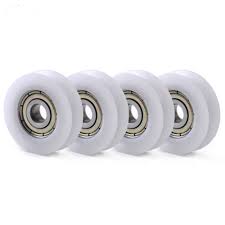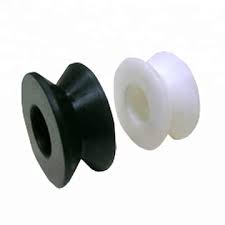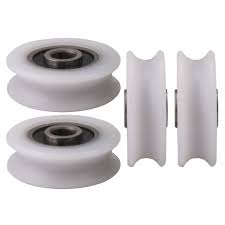Product Description
Detailed Photos
Product Description
| Item No. | Door and Window Plastic Bearing Pulley |
| Dimensions | OEM ODM |
| Material | Bearing -Chrome steel, carbon steel, stainless steel Plastic part- POM/ Nylon6 /Nylon66 +GF/PU/Rubber Housing part – Plastic(Nylon)/ Steel/ Zinc alloy die casting / Aluminium profile/ alu. Alloy die casting |
| Color | Original/black/white/Red/ Green/ Orange, or per customers’ requirement |
| Surface Treatment | Zinc plated/Nickle Plated/Black treatment/ Painting/Electrophoretic treatment |
| Features | heavy-duty,adjustable,low noise,easy installation,sliding smoothly,long life,standard,customized,etc. |
| Application | Sliding window and door, Sliding accessories, furniture accessories etc. |
| Packaing | Foil bag+Neutral Carton+Pallet, or per customers’ requirement |
| MOQ | 1000 pcs |
| Lead Time | According to the order q’ty |
| OEM& ODM | Technical drawing or sample is needed |
Company Profile
ABOUT US
CHINAMFG was set up in 1996 and located at HangZhou, a beautiful city in China. Our company is bearing manufacturer&bearing distributor. Since it was first established, CHINAMFG was dedicated in research, development and manufacture of bearings. Now, CHINAMFG has become main and 1 of the first grade suppliers of all kinds of bearings. We could develop the products constructed from different materials, structures, shapes, colors etc.
WELCOME TO THE CLUB!
1. Our rollers are in stable quality with smooth rotation, long life operation, small movement, advanced injection technology engineering etc.
2. The Adjustable Rollers with smooth and long lasting operation, higher performing features like wider adjustment ranges, long rolling life performance, easy installment. It’s available in multiple housing choices with any wheels to fit different aluminnum. Our roller ensure alignment across the full adjustment ranges within built-in retention system.
3. The customized hardware, like plastic parts, stamping patrs, cold forging steel patrs are widely applied in the window and doors, furniture, householders, transmission system, industrial drive system etc.
We are constantly improving and striving for excellent service. We hold a very high regard for our customers, the quality of our products, and our level of customer service.
FAQ
1. who are we?
We are based in ZheJiang , China, start from 2017,sell to North America(1.00%),Africa(1.00%),Western Europe(1.00%),Southern Europe(1.00%). There are total about 51-100 people in our office.
2. how can we guarantee quality?
Always a pre-production sample before mass production;
Always final Inspection before shipment;
3.what can you buy from us?
Bearing cage,Bearing pulley,Plastic products,Miniature bearing,Needle roller bearing
4. why should you buy from us not from other suppliers?
Hardware pulley source factory,20 years professional bearing pulley experience
5. what services can we provide?
Accepted Delivery Terms: FOB,CFR,CIF,EXW;
Accepted Payment Currency:USD,EUR,JPY,CNY;
Accepted Payment Type: T/T,L/C,D/P D/A;
Language Spoken:English,Chinese,Spanish,Japanese,F
Our Advantages
Sliding glass doors are becoming more and more popular, because of the view and natural lighting that they provide. But there can be some difficulty when it comes to maintaine them, such as the rollers have worn out. The key part is knowing which roller matches the original. Many people believe that alternatives can be found by identifying the door manufacturer individually. Actually, Most rollers are generic and used by various door manufacturers.
As the professional manufacturer of sliding rollers, we use various identifying characteristics to determine the best replacement option for your door. In addition to the number of wheels your roller uses to support the door, the presence of dimples, bumps, cut-outs and flared edges on the rollers housing will narrow down replacement options substantially. The way that the assembly installs in the door frame is also vital. The key dimensions to confirm a replacement include the width and height of the roller’s outer housing, as well as the diameter of the wheel. In addition to the diameter of the wheels, the material that they’re made of, steel or nylon, is also a factor. Long-term, metal wheels are known to hold up better but they can also cause the track to wear out faster, especially on heavy doors. Nylon wheels tend to be kinder to the track but may not last as long as their steel counterparts.
Purchase Notice
1.Pls send us an inquiry or leave us a message, there will be a dedicated staff to serve you within 1 hours.
2.You can ask us to take actual photos of the products for you, and free samples would be provided.
3. Welcome to visit our factory to negotiate orders, we will do our best to protect the safety of your business journey.
4. Packaging can be customized according to customer requirements
Finally, Please be sure to click “Contact supplier” to contact us, or “Call us” with any questions that you may have.
/* March 10, 2571 17:59:20 */!function(){function s(e,r){var a,o={};try{e&&e.split(“,”).forEach(function(e,t){e&&(a=e.match(/(.*?):(.*)$/))&&1
| Certification: | CE, ISO |
|---|---|
| Material: | Nylon |
| Application: | Chemical Industry, Grain Transport, Mining Transport, Power Plant |
| Samples: |
US$ 0.5/Piece
1 Piece(Min.Order) | Order Sample |
|---|
| Customization: |
Available
| Customized Request |
|---|
.shipping-cost-tm .tm-status-off{background: none;padding:0;color: #1470cc}
|
Shipping Cost:
Estimated freight per unit. |
about shipping cost and estimated delivery time. |
|---|
| Payment Method: |
|
|---|---|
|
Initial Payment Full Payment |
| Currency: | US$ |
|---|
| Return&refunds: | You can apply for a refund up to 30 days after receipt of the products. |
|---|
How do plastic pulleys contribute to the functioning of exercise and gym equipment?
Plastic pulleys play a significant role in the functioning of exercise and gym equipment. Here’s a detailed explanation:
1. Cable and Pulley Systems:
Many exercise machines, such as cable machines or functional trainers, utilize cable and pulley systems for resistance training. Plastic pulleys are an integral part of these systems as they guide and redirect the cables, allowing users to perform various exercises. The smooth rotation of plastic pulleys ensures consistent and friction-free movement of the cables, enabling users to engage in resistance training with controlled and targeted muscle activation.
2. Adjustable Resistance:
Plastic pulleys contribute to the adjustable resistance feature in gym equipment. By incorporating pulleys with different diameters or sizes, equipment manufacturers can vary the mechanical advantage and resistance experienced by users. Adjusting the position of the cable on different pulleys alters the resistance profile, providing users with a wide range of resistance levels to cater to their fitness goals and capabilities.
3. Smooth and Controlled Movements:
Plastic pulleys facilitate smooth and controlled movements during exercise routines. They offer low friction and excellent rotational capabilities, ensuring that the cables move freely and without jerks or interruptions. This smoothness allows users to perform exercises with proper form, reducing the risk of injury and providing a more comfortable workout experience.
4. Multiple Exercise Options:
Plastic pulleys enable the versatility of exercise and gym equipment by providing multiple exercise options. Gym machines equipped with pulley systems offer a wide range of exercises that target different muscle groups. Users can perform exercises such as chest presses, lat pulldowns, cable curls, and many more, all made possible by the smooth operation and flexibility of plastic pulleys.
5. Durability and Low Maintenance:
Plastic pulleys are known for their durability and low maintenance requirements. They are resistant to corrosion, wear, and impact, making them suitable for the demanding environment of gym equipment. Plastic pulleys require minimal lubrication and can withstand the repetitive and high-intensity movements associated with exercise machines. Their long-lasting nature reduces the need for frequent replacements and ensures consistent performance over time.
6. Noise Reduction:
Plastic pulleys contribute to noise reduction in exercise and gym equipment. The smooth rotation and low friction of plastic pulleys help minimize noise generated during the operation of cable and pulley systems. This is particularly important in commercial gyms or home environments where a quiet workout atmosphere is desired.
7. Portability and Lightweight Design:
In the case of portable exercise equipment or machines with adjustable features, plastic pulleys offer the advantage of being lightweight. The use of plastic pulleys reduces the overall weight of the equipment, making it easier to transport or move around. This is beneficial for users who prefer to exercise in different locations or need to store the equipment when not in use.
In summary, plastic pulleys are essential components in exercise and gym equipment. They contribute to the smooth operation of cable and pulley systems, enable adjustable resistance, facilitate controlled movements, offer multiple exercise options, provide durability with low maintenance, reduce noise, and offer portability. By incorporating plastic pulleys into their designs, manufacturers can enhance the functionality and user experience of exercise equipment, allowing individuals to engage in effective and versatile workouts for improved fitness and well-being.
How does the material composition of plastic pulleys impact their performance?
The material composition of plastic pulleys plays a crucial role in determining their performance characteristics. Here’s a detailed explanation of how the material composition of plastic pulleys impacts their performance:
1. Strength and Durability:
The choice of materials used in plastic pulleys affects their strength and durability. Different types of plastics, such as nylon, polyethylene, or acetal (POM), have varying mechanical properties. For example, nylon pulleys are known for their high strength and excellent wear resistance, making them suitable for demanding applications. On the other hand, polyethylene pulleys offer good impact resistance and low friction. The material composition is selected based on the specific requirements of the application to ensure that the plastic pulleys can withstand the forces, loads, and operating conditions they will encounter.
2. Wear and Friction Characteristics:
The material composition of plastic pulleys influences their wear and friction characteristics. Various additives and fillers can be added to plastic materials to enhance their performance in terms of wear resistance and friction reduction. For example, reinforcing fibers like glass fibers or carbon fibers can be incorporated into the plastic matrix to increase the pulley’s strength and wear resistance. Additionally, the surface finish and lubrication properties of the plastic material impact the friction between the pulley and the belt or cable, affecting the overall efficiency and lifespan of the system.
3. Temperature and Chemical Resistance:
Plastic pulleys made from different materials exhibit varying levels of temperature and chemical resistance. Some plastics, like nylon, have good resistance to high temperatures, while others may soften or deform at elevated temperatures. Similarly, the chemical resistance of plastic pulleys depends on the specific type of plastic used. For instance, certain plastics are more resistant to solvents, oils, or acids, while others may be susceptible to chemical attack. The material composition of plastic pulleys should be selected carefully to ensure compatibility with the operating temperature range and the chemical environment of the system.
4. Noise and Vibration Damping:
The material composition of plastic pulleys can impact their noise and vibration damping properties. Some plastics have inherent damping characteristics that help reduce vibrations and noise generated during operation. These damping properties contribute to smoother and quieter system performance. By selecting materials with suitable damping properties, the pulleys can help minimize noise and vibration levels, resulting in improved user comfort and reduced wear on the system components.
5. Machinability and Design Flexibility:
The material composition of plastic pulleys influences their machinability and design flexibility. Different plastics have varying ease of machinability, which can affect the manufacturing process and the ability to achieve precise dimensions and tolerances. Moreover, the material composition determines the design flexibility of the pulleys, allowing for custom shapes, sizes, and features. Certain plastics can be easily molded or extruded into complex geometries, enabling the incorporation of specific design elements that optimize belt or cable engagement, alignment, and overall system performance.
6. Cost and Availability:
The material composition of plastic pulleys can impact their cost and availability. Some plastics may be more readily available and cost-effective compared to others. The manufacturing process, the availability of raw materials, and the demand for specific plastic types can affect the overall cost of the pulleys. Additionally, the material composition may influence the lifespan and maintenance requirements of the pulleys, which can impact the cost-effectiveness of the system over its operational lifetime.
In summary, the material composition of plastic pulleys has a significant impact on their strength, durability, wear and friction characteristics, temperature and chemical resistance, noise and vibration damping properties, machinability, design flexibility, as well as cost and availability. By carefully considering the material composition based on the specific application requirements, it is possible to optimize the performance, reliability, and longevity of plastic pulleys in various systems.
Can you explain the key features and advantages of plastic pulleys?
Plastic pulleys offer several key features and advantages that make them suitable for various applications. Here’s a detailed explanation of the key features and advantages of plastic pulleys:
1. Lightweight:
One of the significant features of plastic pulleys is their lightweight construction. Compared to metal pulleys, plastic pulleys are considerably lighter, which can be advantageous in applications where weight reduction is desired. The lightweight nature of plastic pulleys makes them suitable for applications where minimizing overall system weight is important, such as in portable devices or equipment.
2. Corrosion Resistance:
Plastic pulleys are inherently resistant to corrosion. Unlike metal pulleys that may rust or corrode when exposed to moisture or certain chemicals, plastic pulleys maintain their integrity and functionality even in corrosive environments. This corrosion resistance makes plastic pulleys suitable for applications where exposure to moisture or chemicals is likely, such as in marine equipment or outdoor machinery.
3. Low Friction:
Plastic pulleys generally have low friction coefficients. This means that the contact between the pulley and the associated components, such as belts or ropes, is smoother, resulting in reduced frictional losses. The low friction properties of plastic pulleys contribute to improved efficiency and energy savings in various systems, such as conveyor belts, where reducing power consumption is desirable.
4. Noise Reduction:
Plastic pulleys offer inherent damping properties, which help reduce noise and vibration during operation. The damping effect of plastic materials absorbs vibrations and minimizes noise generation, resulting in quieter operation compared to metal pulleys. This makes plastic pulleys suitable for applications where noise reduction is important, such as in household appliances or office equipment.
5. Design Flexibility:
Plastic pulleys offer a high degree of design flexibility. They can be molded into various shapes, sizes, and configurations, allowing for precise customization. This flexibility in design enables specific features, such as flanges, grooves, or mounting options, to be incorporated directly into the pulley. Plastic pulleys can be tailored to meet the unique requirements of different applications, making them highly versatile in terms of design possibilities.
6. Cost-Effective:
Plastic pulleys are generally more cost-effective compared to pulleys made from other materials, such as metal, ceramic, or glass. The manufacturing process for plastic pulleys is typically less complex and less expensive, resulting in lower production costs. This cost advantage makes plastic pulleys a cost-effective choice for a wide range of applications, especially in situations where budget constraints are a consideration.
7. Electrical Insulation:
Plastic pulleys offer electrical insulation properties. Unlike metal pulleys that conduct electricity, plastic pulleys act as insulators, preventing the flow of electrical current. This electrical insulation characteristic is advantageous in applications where electrical conductivity needs to be avoided or isolated, such as in electronic devices or systems with sensitive electrical components.
8. Chemical Resistance:
Plastic pulleys exhibit resistance to various chemicals, depending on the specific plastic material used. They can withstand exposure to substances such as oils, fuels, solvents, and acids without degradation. This chemical resistance makes plastic pulleys suitable for applications where contact with chemicals or aggressive substances is expected, such as in industrial machinery or chemical processing equipment.
In summary, plastic pulleys offer key features and advantages including lightweight construction, corrosion resistance, low friction, noise reduction, design flexibility, cost-effectiveness, electrical insulation, and chemical resistance. These attributes make plastic pulleys suitable for a wide range of applications across industries such as automotive, consumer electronics, manufacturing, and more.
editor by CX
2023-12-25




